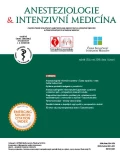Epidural analgesia in obstetrics
Authors:
P. Nosková 1,2; J. Bláha 1,2; J. Mannová 1,3; D. Seidlová 1,4; P. Štourač 1,5
Authors‘ workplace:
Sekce porodnické anestezie a analgezie ČSARIM
1; Klinika anesteziologie, resuscitace a intenzivní medicíny, 1. lékařská fakulta Univerzity Karlovy a Všeobecná fakultní nemocnice v Praze
2; Anesteziologicko-resuscitační oddělení, Nemocnice Havlíčkův Brod
3; II. anesteziologicko-resuscitační oddělení, Fakultní nemocnice Brno
4; Klinika dětské anesteziologie a resuscitace, Fakultní nemocnice Brno, Lékařská fakulta, Masarykova univerzita
5
Published in:
Anest. intenziv. Med., 30, 2019, č. 1, s. 9-13
Category:
Overview
Epidural analgesia for pain relief in labour is the most effective method of obstetric analgesia which is infrequently used in the Czech Republic. The aim of this article is to explain the theory of the method and to describe its practical usage and possible complications.
Keywords:
epidural analgesia – obstetrics
Sources
1. Pařízek A. Indikace epidurální analgezie. In: Pařízek A, a kol. Porodnická anestezie a analgezie. Praha: Grada Publishing, 2002:264–271.
2. Štourač P, Bláha J, Nosková P, et al. Analgesia for labour in the Czech Republic in the year 2011 from the perspective of OBAAMA-CZ study – prospective national survey. Ceska Gynekol. 2015;80:127–34.
3. Bláha J, Štourač P, Grochová M, et al. OBAAMA-INT Study Group. Labour analgesia in Czech republic and Slovakia: a 2015 national survey. Int J Obstet Anesth. 2018;35:42–51.
4. Hawkins J, McQuaid-Hanson E.Anesthesia for the patients with preeclampsia. Up To Date, last aupdatd Jun 15. 2018, dostupné na https://www.uptodate.com/contents/anesthesia-for-the-patient-with-preeclampsia search=anesthesia%20preeclampsia&source=search_result&selectedTitle=1~150&usage_type=default&display_rank=1.
5. Bláha J, Nosková P, Kolníková I, Bláhová K. Tromboprofylaxe a neuroaxiální anestezie v porodnictví. Anest Intenziv. 2012;23:42–49.
6. Bláha J, Černý V, Janků P, et al. Analgezie u vaginálního porodu. Čes Gynek. 2018;83:140–144.
7. Practice Guidelines for Obstetric Anesthesia: An updated report by the American Society of Anesthesiologists Task Force on Obstetric Anesthesia. Anesthesiology 2016;124:270–300.
8. Gumulec J, Šimetka O, Procházka M. Diferenciální diagnostika trombocytopenie v těhotenství. XVI. Pařízkovy dny Ostrava. 2010.
9. Goodman EJ, DeHorta E, Taguiam JM. Safety of spinal and epidural anesthesia in parturients with chorioamnionitis. Reg Anesth. 1996;21:436–441.
10. Horlocker TT, Wedel DJ. Infectious Complications of Regional Anesthesia. Best Practise and Research Clinical Anesthesiology 2008;22(3):451–475
11. Mercier FJ, Bonnet MP. Tattooing and various piercing: anaesthetic considerations. Curr Opin Anaesthesiol. 2009;22:436–441.
12. Creaney M, Mullane D, Casby C, Tan T. Ultrasound to identify the lumbar space in women with impalpable bony landmarks presenting for elective caesarean delivery under spinal anaesthesia: a randomised trial. Int J Obstet Anesth. 2016;12:12–16.
13. Ekinci M, Alici HA, Ahiskalioglu A, et al. The use of ultrasound in planned cesarean delivery under spinal anesthesia for patients having nonprominent anatomic landmarks. J Clin Anesth. 2017;37:82–85.
14. Pařízek A. Farmaka používaná u epidurální analgezie. In: Pařízek A, a kol. Porodnická anestezie a analgezie. Praha: Grada Publishing, 2002:271–280.
15. Shrestha B, Devgan A, Sharma M. Effects of maternal epidural analgesia on the neonate – a prospective cohort study. Ital J Ped. 2014;40:99.
16. Souhrn údajů o přípravku Sufentanil. www.sukl.cz, navštíveno dne 13. 10. 2018.
17. Pařízek A. Porodnická analgezie: luxus nebo nutnost? In: Pařízek A, a kol. Porodnická anestezie a analgezie. Praha: Grada Publishing, 2002:139–141.
18. Obasuyi, BI, Fyneface-Ogan S, Mato, CN. A comparison of the haemodynamic effects of lateral and sitting positions during induction of spinal anaesthesia for caesarean section. International Journal of Obstetric Anesthesia. 2013;22,124–128.
19. Štourač P, Bláha J, Nosková P, et al. Současné postupy v porodnické anestezii IV – celková anestezie u císařského řezu. Anest intenziv Med. 2014;25:123–134.
20. Nosková P, Bláha J, Klozová R, et al. Postpunkční cefalea v porodnictví. Anest intenziv Med. 2014;25:194–202.
21. Heesen M, Klohr S, Rossaint R, et al. Insertion of an intrathecal catheter following accidental dural puncture: a meta-analysis. Int J Obstet Anesth. 2013;22:26–30.
22. Cvachovec K, Černý V, Doležal D, et al. Doporučení pro léčbu toxické reakce po podání lokálních anestetik. http://www.csarim.cz/storage/app/media/Doporucene%20postupy%20a%20stanoviska%20CSARIM/212020dplecbatoxicka-reakcelacsarimfinalapproval140212.pdf, navštíveno 13. 10. 2018.
Labels
Anaesthesiology, Resuscitation and Inten Intensive Care MedicineArticle was published in
Anaesthesiology and Intensive Care Medicine

2019 Issue 1
Most read in this issue
- Clinical presentation and management of phantom pain
- Caudal block in adult patients and its use in the perioperative period
- Epidural analgesia in obstetrics
- Anaesthesia information management systems in the Czech Republic – Are they still just a calling of the future?
